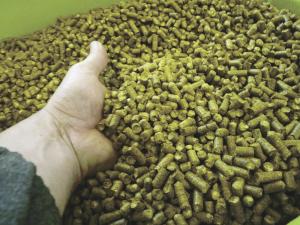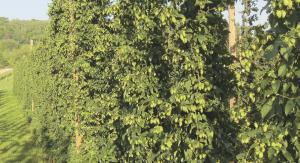Hops Growing Catches On Fast
With more and more microbreweries and hobbyists making specialty beers, the need for hops is growing fast. Potential net profits of $10,000 to $12,000/acre make it an attractive specialty crop. But, James Altwies warns, don’t jump in until you’ve heard the rest of the story and have done your homework.
“It’s extremely challenging,” he says. “The only crop that requires more labor is tobacco. If you are not willing to spend 20 hours a week on an acre of hops, this is not for you.”
That said, Altwies – a horticulturist who loves a challenge – and his 41 contract growers in the Midwest, will grow about 50 acres of hops this year as part of Gorst Valley Hops, based in Wisconsin. Growers take at least a year to do their homework and prepare. Altwies provides the growing, processing and marketing expertise to make it a feasible crop.
These days most hops are commercially grown in the Northwest, but the region around southern Wisconsin was the top hops growing area back in the 1860’s, with its rich, deep soil and ample water supply. “We can’t compete with commodity hops grown in the Northwest. We want to supply hops to brewers that they can’t get elsewhere,” Altwies says.
He explains that hop cones are full of oils and compounds that preserve and add the bittering flavor and balance to beer. Gorst Valley Hops has chemists who work with breweries to redesign and custom blend hops specifically for them.
“It’s horticulture, but using technology behind it to add value,” Altwies says. He works with each grower to create a prescription for maximizing production on a specific piece of property.
Hops plants are herbaceous perennials that can grow more than 20 ft. tall on a trellis system. They climb up vertical 16-ft. strings of coir twine (made of coconut husk fiber) attached to cable, which is anchored to posts set every 50 ft. One acre accommodates about 1,200 hops plants, which are started with root cuttings from a mature plant. A surface drip irrigation system ensures plants receive enough water – as much as 20,000 gal./acre/week in July.
Late spring and early summer are especially busy, putting up the twine, pruning suckers on the ground and training the plants to climb the twine. There’s also constant weeding and monitoring for pests, mildew and diseases that can wipe out an entire crop. Hops require 200 lbs. of nitrogen/acre applied at just the right time.
Harvest time is even more crucial.
“There are five days on either side of a perfect day to harvest. It’s a flower, and it’s critical to get the timing just right,” Altwies says.
The plants are cut down and taken to a machine that separates out the flower (or seed cone), which contains about 80 percent moisture. They are dried to about 10 percent, and then taken to Gorst Valley to be stored and then processed into small pellets that are vacuum-sealed and frozen.
The gross value of mature plants (3 years and older) averages just over $20,000/acre and the net is $10,000 to $12,000/acre.
Altwies emphasizes the importance of constant monitoring, weeding and proper watering and nutrient application to get a good yield – an average of 1,500 lbs. of dry flowers/acre.
Gorst Valley growers receive 70 percent of the sale of their hops. Gorst is paid for processing, technical, lab, marketing and other services. It also holds the food-handling license, which is required in Wisconsin.
Unless you grow just a few plants as a hobby to make your own beer, it makes sense to be part of a group of growers, Altwies says. Growers in his group come from a variety of backgrounds including dairy, cash crop, hobby and people who have never farmed. Most live in Wisconsin, but he has growers in Michigan, Minnesota, Illinois and Indiana.
As the market grows, Altwies hopes to expand in those states as well as Ohio. He offers Hops 101 workshops 3 or 4 times a year for people interested in growing for their own use or as a crop.
“There’s no rushing into this,” he advises. “Go into it with your eyes wide open.”
Contact: FARM SHOW Followup, Gorst Valley Hops (ph 608 228-3117; www.gorstvalleyhops.com).

Click here to download page story appeared in.
Click here to read entire issue
Hops Growing Catches On Fast CROPS New Crops With more and more microbreweries and hobbyists making specialty beers the need for hops is growing fast Potential net profits of $10 000 to $12 000/acre make it an attractive specialty crop But James Altwies warns don’t jump in until you’ve heard the rest of the story and have done your homework “It’s extremely challenging ” he says “The only crop that requires more labor is tobacco If you are not willing to spend 20 hours a week on an acre of hops this is not for you ” That said Altwies – a horticulturist who loves a challenge – and his 41 contract growers in the Midwest will grow about 50 acres of hops this year as part of Gorst Valley Hops based in Wisconsin Growers take at least a year to do their homework and prepare Altwies provides the growing processing and marketing expertise to make it a feasible crop These days most hops are commercially grown in the Northwest but the region around southern Wisconsin was the top hops growing area back in the 1860’s with its rich deep soil and ample water supply “We can’t compete with commodity hops grown in the Northwest We want to supply hops to brewers that they can’t get elsewhere ” Altwies says He explains that hop cones are full of oils and compounds that preserve and add the bittering flavor and balance to beer Gorst Valley Hops has chemists who work with breweries to redesign and custom blend hops specifically for them “It’s horticulture but using technology behind it to add value ” Altwies says He works with each grower to create a prescription for maximizing production on a specific piece of property Hops plants are herbaceous perennials that can grow more than 20 ft tall on a trellis system They climb up vertical 16-ft strings of coir twine made of coconut husk fiber attached to cable which is anchored to posts set every 50 ft One acre accommodates about 1 200 hops plants which are started with root cuttings from a mature plant A surface drip irrigation system ensures plants receive enough water – as much as 20 000 gal /acre/week in July Late spring and early summer are especially busy putting up the twine pruning suckers on the ground and training the plants to climb the twine There’s also constant weeding and monitoring for pests mildew and diseases that can wipe out an entire crop Hops require 200 lbs of nitrogen/acre applied at just the right time Harvest time is even more crucial “There are five days on either side of a perfect day to harvest It’s a flower and it’s critical to get the timing just right ” Altwies says The plants are cut down and taken to a machine that separates out the flower or seed cone which contains about 80 percent moisture They are dried to about 10 percent and then taken to Gorst Valley to be stored and then processed into small pellets that are vacuum-sealed and frozen The gross value of mature plants 3 years and older averages just over $20 000/acre and the net is $10 000 to $12 000/acre Altwies emphasizes the importance of constant monitoring weeding and proper watering and nutrient application to get a good yield – an average of 1 500 lbs of dry flowers/acre Gorst Valley growers receive 70 percent of the sale of their hops Gorst is paid for processing technical lab marketing and other services It also holds the food-handling license which is required in Wisconsin Unless you grow just a few plants as a hobby to make your own beer it makes sense to be part of a group of growers Altwies says Growers in his group come from a variety of backgrounds including dairy cash crop hobby and people who have never farmed Most live in Wisconsin but he has growers in Michigan Minnesota Illinois and Indiana As the market grows Altwies hopes to expand in those states as well as Ohio He offers Hops 101 workshops 3 or 4 times a year for people interested in growing for their own use or as a crop “There’s no rushing into this ” he advises “Go into it with your eyes wide open ” Contact: FARM SHOW Followup Gorst Valley Hops ph 608 228-3117; www gorstvalleyhops com
To read the rest of this story, download this issue below or click
here to register with your account number.








